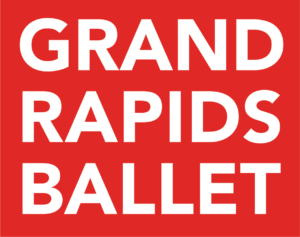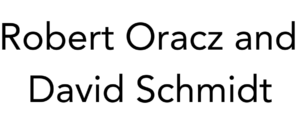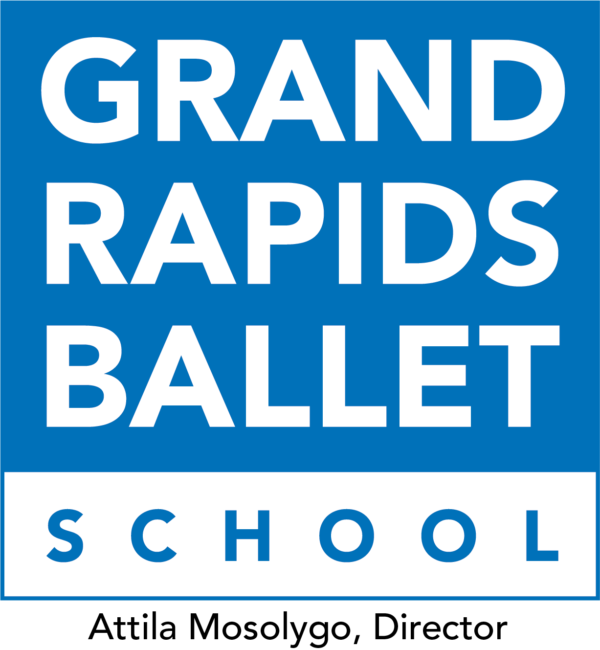SYMPHONY OF MOVEMENT
October 11-13, 2024 at Peter Martin Wege Theatre
We are proud to kick off our 2024-25 season in October with Symphony of Movement, a dynamic first-ever collaboration between GRB and the Grand Rapids Symphony at the Peter Martin Wege Theatre. Conducted by GRSO’s music director Marcelo Lehninger, the symphony shares the stage with the dancers, featuring three acclaimed works and one world-premiere. Programming includes master choreographer Lar Lubovitch’s tender duet for two men, from his work Concerto 622, set to the adagio of W.A. Mozart’s famous clarinet concerto. Created during the AIDS crisis in 1985, the work reflects on the themes of friendship and support amidst challenging times. Aubade, choreographed by James Sofranko, is an emotionally charged pas de deux that loosely follows a story of the goddess Diana and a mortal man who enters her domain, set to a score by Francis Poulenc, featuring piano soloist Liz Ames. Ave Maria, also choreographed by James Sofranko, is a captivating duet accompanied by the ethereal music of Carlos Gomes, with the two dancers appearing to transcend reality, gracefully navigating a world suspended among the wind and clouds. The final work featured in the program is a World Premiere choreographed by Jennifer Archibald set to Edvard Grieg’s Holberg Suite. As a leading voice in contemporary dance, Archibald’s work is seen around the world, and this will be her third original work for Grand Rapids Ballet.
SYMPHONY OF MOVEMENT | DATES & TIMES
Friday, October 11, 2024
Evening Performance at 7:30 p.m. | Get Tickets
Saturday, October 12, 2024
Matinee performance at 2 p.m. | Get Tickets
Evening Performance at 7:30 p.m. | Get Tickets
Sunday, October 13, 2024
Matinee performance at 2 p.m. | Get Tickets
SYMPHONY OF MOVEMENT | CREATORS

Jennifer Archibald
Biography
JENNIFER ARCHIBALD is the founder and Artistic Director of the Arch Dance Company and Program Director of ArchCore40 Dance Intensives. She is a graduate of The Alvin Ailey School and the Maggie Flanigan Acting Conservatory where she studied the Meisner Technique. Archibald has choreographed for the Atlanta Ballet, Ailey II, Cincinnati Ballet, Ballet Memphis, Kansas City Ballet, Tulsa Ballet, Ballet Nashville, Grand Rapids Ballet, Amy Seiwert’s Imagery, and Stockholm’s Balletakademien, Canadian Contemporary Dance Theatre and worked commercially for Tommy Hilfiger, NIKE and MAC Cosmetics as well as chart-listed singers and actors. She was the first female Resident Choreographer in Cincinnati Ballet’s 40-year history for seven years under the direction of Victoria Morgan. For 2024 Jennifer is commissioned to create works for Smuin Ballet, Washington Ballet, BalletMet and is the guest choreographer for Pathways to Performance Reframing the Narrative at the Kennedy Center. She was appointed as Movement Director for Michael Kahn’s closing season for The Oresteia at the Shakespeare Theatre Company. She was also the 2018-19 recipient’s for the CUNY Dance Initiative Residency.
Archibald’s works have been performed at venues including New York’s City Center, Lincoln Center, The Kennedy Center, Aaron Davis Hall, Jacob’s Pillow Inside|Out Stage and Central Park’s Summerstage Mainstage. Jennifer was awarded a Choreographic Fellow for Ailey’s New Directions Choreography Lab under the direction of Robert Battle. She is a Choreographic Winnings recipient by the Joffrey Ballet. Jennifer choreographed “Seven”, a biographical work about Olympian Jackie Joyner-Kersee, commissioned by St. Louis based MADCO Dance Company. Her work for Stockholm’s Balettakademien “Delilah” toured Scandinavia. She is the creator of the Documentary Ballet format, where she creates works rooted in historical history bringing communities together. The Documentary Ballets are inclusive and communal projects. Breaking’Bricks honors the community of Black Wall Street in Tulsa Oklahoma produced by Tulsa Ballet and Pittsburgh Ballets produced Sounds of the Sun honoring the life of dancer Florence Waren exploring her experience during the holocaust. Documentary Ballets are theatrical engagements that evolve beyond the stage, with historical education as an integral part of the creative process.
Dance Magazine considers Ms. Archibald a major player on the college circuit Jennifer is currently an Acting Lecturer at the David Geffen School of Drama at Yale. In 2015, she was appointed as Guest Faculty Lecturer to develop the Hip Hop dance curriculum at Columbia/Barnard College. Jennifer is also a guest artist at several universities including Fordham/Ailey, Purchase College, Princeton, Virginia Commonwealth University, University of South Florida, Goucher College, Columbia College Chicago, Bates College, Boston Conservatory, Point Park University, Miami New World School of the Arts, South Carolina’s Governor’s School of the Arts, Ailey Fordham, Austin University, Oklahoma University, University of Missouri, Jacksonville University, and University of Alabama, and New York Tisch University. Internationally, she has taught master classes in Switzerland, Brazil, Bermuda, Canada, Italy, Slovenia, Sweden, France, Russia, Mexico, China, and Ecuador.
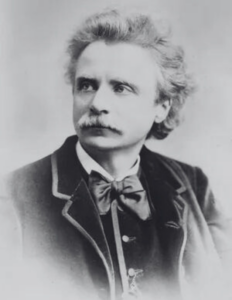
Edvard Grieg
Biography
Edvard Grieg (1843 – 1907) was a composer from Norway who is probably best-known for his composition In the Hall of the Mountain King. This fairytale-inspired piece evokes the sound of subterranean trolls, gnomes, and goblins and comes from a larger work of music that was performed during a play by Henrik Ibsen named Peer Gynt. This play was based on a Norwegian fairy tale of the same name. Like composers Jean Sibelius of Finland and Antonín Dvořák of Czechia, Grieg was inspired by folk music of his native land and worked to capture the sounds of Norway within his own music. In fact, Grieg loved his home so much that he named his house Troldhaugen, which means Troll Hill, and even named a piano piece after it called Wedding at Troldhaugen. Throughout his life, Edvard Grieg composed many pieces, including piano pieces, orchestral works, choral works, songs, and chamber music.
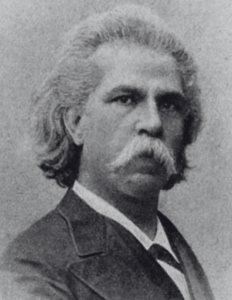
Carlos Gomes
Biography
He was born in the village of São Carlos, in the city of Campinas, Brazil. He was born in Brazil but spent most of his working life in Italy. He was the he first Brazilian composer to gain international fame. Although he was Brazilian by birth he was actually one fourth Indian, his grandmother was a full blooded Guarany Indian who married a Spanish immigrant. His Parents were Maestro Manuel José Gomes and Fabiana Maria Jaguari Cardoso. His father a band conductor gave him his first musical training and he learnt to play several musical instruments. At the age of 18, he composed his first Mass for his church. And at the age of 20 gave music lessons to help support his family. Family issues forced Carlos Gomes to leave home and travel to Rio de Janeiro, where he became a protégé of Emperor of Brazil Dom Pedro II court. He impressed the Emperor Don Pedro II with his talents, that the emperor recommended he entered the Imperial Conservatory. He studied under Joaquin Giannini, who introduced him to the Italian opera canon. He also impressed his other teachers that Jose Amat, the director of the National Opera hired as a pianist. He composed his first opera, The Night of the Castle (A Noite no Castelo), in 1861. He graduated from University with honors and a few years later composed a second opera. Joan of Flanders (Joana de Flandres) earned him a scholarship to study in Italy at the Milan Conservatory with teachers Lauro Rossi and Alberto Mazzucato. He earned the degree of Maestro Compositori. In 1870, he made a major business deal mistake by selling off his musical rights of his most famous opera, Il Guarany (O Guarani), based on the book of the same name by author José de Alencar, while living in Italy. He married Adelina Peri, an Italian pianist he had met while studying in Milan, together they had five children. Carlos Gomes was a master of both the Brazilian and Italian style but enjoyed his greatest successes in Italy where his works are generally considered part of the Italian school rather than Brazilian. In 1895 he would finally returned to Brazil to live and work becoming the director of the Music Conservatory of Belém, Pará. A year later he died after a long battle with throat cancer.

Marcelo Lehninger
Biography
Brazilian-born Marcelo Lehninger is Music Director of the Grand Rapids Symphony and was recently appointed Artistic Director of the Bellingham Festival of Music. In 2018, he brought the Grand Rapids Symphony to Carnegie Hall, its first performance at the famed venue in thirteen years. He previously served as Music Director of the New West Symphony in Los Angeles, for which the League of American Orchestras awarded him the Helen H. Thompson Award for Emerging Music Directors. For five years, Lehninger served as Assistant and then Associate Conductor of the Boston Symphony Orchestra, a tenure that included many concerts in Boston, Tanglewood and a highly praised debut at Carnegie Hall in 2011.
As a guest conductor, Lehninger has led some of the leading orchestras in the United States, including the Chicago, Boston, Pittsburgh, St. Louis, Houston, Detroit, Baltimore, Seattle, National, Milwaukee, North Carolina, Indianapolis, Colorado, Charlotte, New Jersey, Jacksonville, Omaha, Chautauqua, Portland, Princeton, Hartford, Hawaii, Tulsa, Vancouver, Tucson, Toledo, and Fairfax Symphonies; the Florida, Louisville and Sarasota Orchestras; and the Rochester, Buffalo, Orlando, New Mexico, and Colorado Springs Philharmonics.
In Canada, Lehninger has appeared with the Toronto, Winnipeg, and Kitchener-Waterloo Symphonies, the Calgary and Hamilton Philharmonics, and the Symphony Nova Scotia.
European highlights include engagements with the Deutsches Symphonie-Orchester Berlin, Orchestre Philharmonique de Radio France, Orchestre National de France, Orchestre National du Capitole de Toulouse, Lucerne Symphony, Lausanne Chamber Orchestra, Prague Philharmonia, Budapest’s MAV Symphony, Slovak State Philharmonic, regular visits to the Slovenian Philharmonic, including on tour to Vienna’s Konzerthaus, and a tour with the Royal Concertgebouw Orchestra assisting Mariss Jansons.
He made his Australian debut with the Sydney and Melbourne Symphonies with his friend and mentor Nelson Freire as soloist. In Japan, he conducted the Yomiuri Nippon Symphony in Tokyo and the Kyushu Symphony Orchestra in Fukuoka.
Lehninger was Music Advisor of The Orchestra of the Americas for the 2007-08 season. In summer of 2008, he toured with the orchestra in South America, conducting concerts in Argentina, Brazil, and Uruguay. He has led all of the top orchestras in Brazil, and served as Associate Conductor of the Minas Gerais Philharmonic Orchestra, where he returns regularly as guest conductor.
Chosen by Kurt Masur in 2008, Lehninger was awarded the First Felix Mendelssohn-Bartholdy Scholarship sponsored by the American Friends of the Mendelssohn Foundation. He was Maestro Masur’s assistant with the Orchestre National de France (during their residency at the Musikverein in Vienna), Gewandhaus Orchestra in Leipzig, and the New York Philharmonic. In 2011, he participated in the Bruno Walter National Conductor Preview, organized by the League of American Orchestras, conducting the Louisiana Philharmonic, and debuted with the National Symphony Orchestra at the Kennedy Center as part of the National Conducting Institute in 2007.
Before dedicating his career to conducting, Lehninger studied violin and piano. He holds a Master’s degree from the Conductors Institute at New York’s Bard College, where he studied conducting under Harold Farberman and composition with Laurence Wallach. His mentors also include Kurt Masur, Mariss Jansons, Leonard Slatkin, and Roberto Tibiriçá. A dual citizen of Brazil and Germany, Marcelo Lehninger is the son of Brazilian pianist Sônia Goulart and German violinist Erich Lehninger.
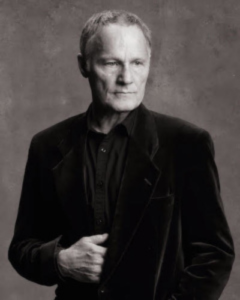
Lar Lubovitch
Biography
Lar Lubovitch is one of America’s most versatile and widely seen choreographers. He founded the Lar Lubovitch Dance Company in 1968. Over the course of 54 years, it has gained an international reputation as one of America’s top dance companies, produced more than 120 dances and performed before millions across the U.S. and over 40 countries. Many other major companies throughout the world have performed the company’s dances, including American Ballet Theatre, New York City Ballet, San Francisco Ballet, Paris Opera Ballet, Royal Danish Ballet, Alvin Ailey American Dance Theater, the Joffrey Ballet, Martha Graham Dance Company, and more. Lubovitch has created ice-dancing works for Olympians John Curry, Peggy Fleming, Dorothy Hamill, Brian Orser, JoJo Starbuck, and Paul Wylie, and he has created feature-length ice-dance specials for TV: “The Planets” for A&E (nominated for an International Emmy Award, a Cable AceAward, and a Grammy Award) and “The Sleeping Beauty” for PBS and Anglia TV, Great Britain. His theater and film work includes Sondheim/ Lapine’s Into the Woods (Tony Award nomination), The Red Shoes (Astaire Award), the Tony Award-winning revival of The King and I (on Broadway and in London’s West End), Disney’s Hunchback of Notre Dame in Berlin, and Robert Altman’s movie The Company (American Choreography Award). In 2016, he premiered “The Bronze Horseman,” based on the Pushkin poem, for the Mikhailovsky Ballet in Russia. In 1987, he conceived Dancing for Life, which took place at Lincoln Center. It was the first response by the dance community to the AIDS crisis, raising over one million dollars. Together with Jay Franke, in 2007 Lubovitch created the Chicago Dancing Festival, in collaboration with the City of Chicago and the Museum of Contemporary Art. It presented 10 seasons entirely free to the public. Recent awards: 2007 named Chicagoan of the Year by the Chicago Tribune; 2008 named similarly by Chicago Magazine; 2011 designated a Ford Fellow by United States Artists and received the Dance/USA Honors Award; 2012 his dance “Crisis Variations” awarded the Prix Benois de la Danse for outstanding choreography at the Bolshoi Theatre; 2013 honored for lifetime achievement by the American Dance Guild; 2014 awarded an honorary doctorate by The Juilliard School; 2016 received the Scripps/American Dance Festival Award for lifetime achievement and the Dance Magazine Award, named one of America’s Irreplaceable Dance Treasures by the Dance Heritage Coalition and appointed a Distinguished Professor at UC/Irvine. In honor of his company’s 50th anniversary, in 2018 he was presented with the Martha Graham Award for lifetime achievement.
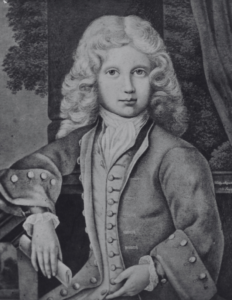
W.A. Mozart
Biography
Wolfgang Amadeus Mozart was born on January 27, 1756, in Salzburg, Austria. His father, Leopold Mozart, a noted composer, instructor, and the author of famous writings on violin playing, was then in the service of the archbishop of Salzburg. Leopold and Anna Maria, his wife, stressed the importance of music to their children. Together with his sister, Nannerl, Wolfgang received such intensive musical training that by the age of six he was a budding composer and an accomplished keyboard performer. In 1762 Leopold presented his son as performer at the imperial court in Vienna, Austria, and from 1763 to 1766 he escorted both children on a continuous musical tour across Europe, which included long stays in Paris, France, and London, England, as well as visits to many other cities, with appearances before the French and English royal families.
Mozart was the most celebrated child prodigy (an unusually gifted child) of this time as a keyboard performer. He also made a great impression as a composer and improviser (one who arranges or creates). In London he won the admiration of musician Johann Christian Bach (1735–1782), and he was exposed from an early age to an unusual variety of musical styles and tastes across Europe.
From the age of ten to seventeen, Mozart’s reputation as a composer grew to a degree of maturity equal to that of most older established musicians. He spent the years from 1766 to 1769 at Salzburg writing instrumental works and music for school dramas in German and Latin, and in 1768 he produced his first real operas: the German Singspiel (that is, with spoken dialogue) Bastien und Bastienne. Despite his growing reputation, Mozart found no suitable post open to him; and his father once more escorted Mozart, at age fourteen (1769), and set off for Italy to try to make his way as an opera composer.
In Italy, Mozart was well received: in Milan, Italy, he obtained a commission for an opera; in Rome he was made a member of an honorary knightly order by the Pope; and at Bologna, Italy, the Accademia Filarmonica awarded him membership despite a rule normally requiring candidates to be twenty years old. During these years of travel in Italy and returns to Salzburg between journeys, he produced his first large-scale settings of opera seria (that is, court opera on serious subjects): Mitridate (1770), Ascanio in Alba (1771), and Lucio Silla (1772), as well as his first string quartets. At Salzburg in late 1771 he renewed his writing of Symphonies (Nos. 14–21).
Paris was a vastly larger theater for Mozart’s talents. His father urged him to go there, for “from Paris the fame of a man of great talent echoes through the whole world,” he wrote his son. But after nine difficult months in Paris, from March 1778 to January 1779, Mozart returned once more to Salzburg, having been unable to secure a foothold and depressed by the entire experience, which had included the death of his mother in the midst of his stay in Paris. Unable to get hired for an opera, he wrote music to order in Paris, again mainly for wind instruments: the Sinfonia Concertante for four solo wind instruments and orchestra, the Concerto for flute and harp, other chamber music, and the ballet music Les Petits riens. In addition, he began giving lessons to make money.
Mozart’s years in Vienna, from age twenty-five to his death at thirty-five, cover one of the greatest developments in a short span in the history of music. In these ten years Mozart’s music grew rapidly beyond the realm of many of his contemporaries; it exhibited both ideas and methods of elaboration that few could follow, and to many the late Mozart seemed a difficult composer.
The major instrumental works of this period bring together all the fields of Mozart’s earlier activity and some new ones: six symphonies, including the famous last three: no. 39 in E-flat Major, no. 40 in G Minor, and no. 41 in C Major (the Jupiter —a title unknown to Mozart). He finished these three works within six weeks during the summer of 1788, a remarkable feat even for him.
In the field of the string quarter Mozart produced two important groups of works that completely overshadowed any he had written before 1780: in 1785 he published the six Quartets (K. 387, 421, 428, 458, 464, and 465) and in 1786 added the single Hoffmeister Quartet (K. 499). In 1789 he wrote the last three Quartets (K. 575, 589, and 590), dedicated to King Frederick William (1688–1740) of Prussia, a noted cellist.
Mozart’s development as an opera composer between 1781 and his death is even more remarkable, perhaps, since the problems of opera were more far-ranging than those of the larger instrumental forms and provided less adequate models. The first important result was the German Singspiel entitled Die Entführung aus dem Serail (1782; Abduction from the Seraglio). Mozart then turned to Italian opera. Mozart produced his three greatest Italian operas: Le nozze di Figaro (1786; The Marriage of Figaro), Don Giovanni (1787, for Prague), and Cosi fan tutte (1790). In his last opera, The Magic Flute (1791), Mozart turned back to German opera, and he produced a work combining many strands of popular theater and including musical expressions ranging from folk to opera.
On concluding The Magic Flute, Mozart turned to work on what was to be his last project, the Requiem. This Mass had been commissioned by a benefactor (financial supporter) said to have been unknown to Mozart, and he is supposed to have become obsessed with the belief that he was, in effect, writing it for himself. Ill and exhausted, he managed to finish the first two movements and sketches for several more, but the last three sections were entirely lacking when he died. It was completed by his pupil Franz Süssmayer after his death, which occurred in Vienna, Austria, on December 5, 1791.

Francis Poulenc
Biography
1899 Birth of Francis Poulenc on 7 January. His father, Emile Poulenc, born in 1855, is an industrialist from the Aveyron region who, with his two brothers, runs a chemical factory. His mother, Jenny Royer, is from a family of artisans whose Parisian roots date back several generations.
1904 Jenny sits the young Francis down at the piano and makes him practice Mozart, Schubert and Chopin as well as fashionable romances, ‘loveable bad music’.
1911-13 ‘Oncle Papoum’ (Marcel Royer, Jenny’s brother), who frequently attends the Opéra-Comique, light comedies and avant-garde concerts, reveals Petrushka and The Rite of Spring to the young Francis. This is a veritable revelation, and, throughout his whole life, Stravinsky will remain a master whom he admires immensely.
1914 As his father insists that he do general and studies and not devote himself exclusively to music, Francis Poulenc does not attend the Conservatoire; meets Ricardo Viñes, Catalan professor introduced by Geneviève Sienkiewicz.
1914-17 Viñes teaches him the music of his time – that of Debussy, Stravinsky and Satie – and introduces him to Cocteau, Marcelle Meyer and Satie. The young Poulenc also meets Milhaud.
1915 Death of his mother, Jenny.
1917 Death of his father. Moves in with his sister Jeanne (1887-1974) and her husband, on Rue de Monceau.
Thanks to his childhood friend Raymonde Linossier (1897-1930), Poulenc discovers the Parisian intellectual and literary milieu: first regular visits to Adrienne Monnier’s bookshop (La Maison des Amis des Livres), located at 7 Rue de l’Odéon, where he will be able to meet Aragon, Breton, Eluard and Apollinaire. There, the latter, who will have a lasting influence on Poulenc, reads his own poems and in June gives the premiere of Les Mamelles de Tirésias, a work that Poulenc will set to music in the late ‘40s.
11 December: first performance of Rapsodie nègre, his first work, for voice (baritone) and instrumental ensemble (flute, clarinet, string quartet and piano).
1918 Mobilisation in January at Vincennes, then at the War Ministry until 1921. Meets Manuel de Falla at the home of Ricardo Viñes.
1918 First group of compositions, which, with Stravinsky’s help, will be included in the catalogue of the London publisher Chester as of the following year: Toréador, on poems by Jean Cocteau, the Sonata for 2 Clarinets, the Sonata for Piano 4 hands, the three Mouvements perpétuels. Regularly sees Jean Cocteau, Raymond Radiguet, Max Jacob.
1919 Premiere of Le Bestiaire on poems by Guillaume Apollinaire (with Suzanne Peignot, friend and first interpreter of the composer’s mélodies).
1920 Cocardes, premiered at the Théâtre des Champs-élysées, enjoys a fine success. These three songs on a poem by Cocteau are inspired by the atmosphere of Nogent-sur-Marne – that of fun fairs and open-air dance halls – where Poulenc spends his holidays with family and friends.
Le Groupe des Six (Auric, Durey, Honegger, Milhaud, Poulenc and Tailleferre) is formed.
1921 Le Gendarme Incompris, text by Jean Cocteau and Raymond Radiguet, presented in May at the Théâtre Michel. Premiere in June of Les Mariés de la tour Eiffel, first important work by Les Six, reduced, for this occasion, to five (Poulenc, Auric, Milhaud, Honegger, Tailleferre). Misia Sert attends the performance and introduces the young Poulenc to Serge Diaghilev, the great master of Les Ballets Russes, very much in vogue in the early Twenties.
Beginning of the precious piano teaching of Charles Koechlin (1867-1950), which will last four years; from him Poulenc will learn counterpoint technique and choral writing.
1922 Quatre Poèmes de Max Jacob. Sonata for Clarinet and Bassoon, Sonata for Horn, Trumpet and Trombone. Meets Henri Sauguet. For a few weeks, Poulenc accompanies Darius Milhaud and Marya Freund in Central Europe; he meets Berg, Schoenberg and Webern in Vienna.
1924 At the request of Serge Diaghilev, he composes the ballet Les Biches, premiered in January by the Ballets Russes in Monte-Carlo; sets and costumes by Marie Laurencin. The work achieves a great success.
1926 First performance in May of the Trio for Oboe, Bassoon and Piano and of Chansons gaillardes with Pierre Bernac. Wanda Landowska, whom he met at the Princess de Polignac’s, commissions a concerto for harpsichord from Poulenc.
1927 Acquisition of Le Grand Coteau, his country home, midway between a mansion and a wine-grower’s house, surrounded by vineyards and terraces decorated with gardens à la française. This property, located next to the village of Noizay, between Amboise and Vouvray in Touraine, allows the composer to flee the distractions of Paris and get down to composing in beneficial solitude.
1929 First performance in May of the Concert champêtre by Wanda Landowska and the Paris Symphony Orchestra, conducted by Pierre Monteux in Paris. Composition of eight Nocturnes for solo piano.
Premiere of Aubade, for piano and 18 instruments, to a commission from Vicomte Charles and Vicomtesse Marie-Laure de Noailles.
1930 The death of Raymonde Linossier on 30 January will profoundly affect Poulenc, who felt a very close friendship—or even certainly an unavowed love—for her, dating back to childhood.
1931 Premiere of two song cycles: 4 Poèmes de Guillaume Apollinaire and 5 Poèmes de Max Jacob.
1932 First performance of Le Bal masqué, secular cantata for baritone and chamber orchestra after Max Jacob, to a commission by the Noailleses.Concerto for 2 Pianos to a commission by the Princess Edmond de Polignac in which are found themes inspired by Ravel, Mozart (Concerto K 537 assuredly) and jazz. The premiere takes place on 5 September in Venice, with Francis Poulenc and Jacques Février as soloists accompanied by the Orchestra of La Scala of Milan.
1933 First performance of the Sextet, which will subsequently be revised in 1939, and Improvisations for piano, given for the first time at Salle Gaveau in Paris. As the new works do not bring in much, Poulenc gives his first lectures and begins playing in concert in order to earn a somewhat better living.
1934 8 Chansons polonaises, premiered by singer Marya Modrakowska. In March 5 Poèmes de Pierre Ronsard , performed by soprano Suzanne Peignot, with piano, then the version with orchestra in December. Poulenc is invited on 21 August to participate in a concert of French music in Salzburg.
At his hotel, he finds a note from Pierre Bernac, the baritone of the Chansons gaillardes, inviting him to accompany the singer in Debussy. This unexpected encounter will be the catalyst for Poulenc to get closer to the artist who will henceforth give the first performance of all the future songs for male voice up to the end of their joint career.
1936 Composition of Les Soirées de Nazelles for piano, in the spirit of Couperin’s Folies Françaises, as described by the composer. Moves into Oncle Papoum’s building at 5 Rue de Médicis, facing the Luxembourg Palace.After learning of the terrible death of his friend the composer Pierre-Octave Ferroud in a road accident, Poulenc visits the sanctuary of the Black Virgin in Rocamadour. This triggers a huge religious shock in like a veritable spiritual revelation that will have a lasting effect on his music. In one week, he finishes the composition of Litanies à la Vierge Noire, for women’s chorus and organ. It will be given its first performance on 17 November by Nadia Boulanger, during a BBC concert in London. The first French performance will take place in Lyons, at Salle Rameau, on 3 May 1937, by Les Chœurs de Lyon, at a concert broadcast live over the radio
1937 First performance, with Pierre Bernac, on 3 February at Salle Gaveau of Telle jour telle nuit on poems by Paul Eluard. This cycle is certainly one of Poulenc’s most accomplished and reflects exceptional unity of construction. Premiere on 21 May at Gaveau of Sept Chansons pour chœur a cappella. First performance, in Lyons, of Sécheresses, a contemporary work for mixed chorus and orchestra on poems by Edward James (1908-1984), which, up to the present day, remains particularly ill-known and rarely performed.
1938 Premiere by Les Chœurs de Lyon of the Mass in G major, 3 April in Paris, his first a cappella religious work. First performance of 3 Poèmes de Louise de Vilmorin at Salle Gaveau on 28 November 1938 Priez pour Paix, September.
1939 After a first, private performance given in December 1938 in the Polignac home, the Concerto for Organ, Strings and Timpani has its first public performance on 21 June 1939 at Salle Gaveau; Maurice Duruflé is soloist, and Roger Desormière conducts the Paris Symphony Orchestra. First performance of 4 Motets pour un temps de pénitence on Latin texts for mixed chorus a cappella in February at the church of Saint-Etienne-du-Mont by the Petits Chanteurs à la Croix de Bois. Final version of the Sextet and Fiançailles pour rire, a song cycle on poems by Louise de Vilmorin.
1940 Called up in Bordeaux then discharged in Brive-la-Gaillarde, Poulenc begins working on L’Histoire de Babar and his song cycle Banalités on poems by Apollinaire.
1941 Two motets for mixed chorus a cappella are written in May: Salve Regina and Exultate Deo.
1942 Fiançailles pour rireis premiered by Geneviève Touraine, sister of baritone Gérard Souzay, on 21 May 1942 at the Ecole Normale de Musique, later renamed Salle Cortot. 8 August: premiere of the ballet Les Animaux modèles at the Paris Opera (choreography by Serge Lifar).
1943 Sonata for Violin and Piano, dedicated to the memory of Federico García Lorca, in June; the composer will deem it a failure. The same month, Poulenc gives the first performance of Les Chansons villageoises in a version for voice and orchestra; nowadays, the version with piano is almost systematically performed. Métamorphoses, on poems by Louise de Vilmorin, and ‘C’, on texts by Louis Aragon. Ricardo Viñes dies in the spring.
1944 In February, Max Jacob, a Jew, is arrested by the Gestapo in Orléans then deported to the camp in Drancy, where he dies of exhaustion two weeks later in spite of various interventions, including those of Jean Cocteau and Sacha Guitry, to have him released. Composition at Christmas of Un soir de neige a polyphonic a cappella work on poems by Paul Eluard; the first performance will be given on 21 April 1945 in Paris.
1945 Figure humaine, for double chorus a cappella on poems by Paul Eluard, first performed in English by the BBC Singers of London, on 25 March, then in French on 2 December 1946 in Brussels by the Flemish Radio Chorus. This work of great modernity and polyphonic mastery marks a turning point in the composer’s work.
January 1945 is also the occasion for Poulenc to play his Concerto for 2 Pianos in London with Benjamin Britten. The first Poulenc-Bernac recital is given the same year at Wigmore Hall.
1946 First performance on 14 June of L’Histoire de Babar, based on Jean de Brunhoff’s text, with Pierre Bernac narrator.
1947 Moves into a larger (6th floor) flat at 5 Rue de Médicis, where the composer will live until his death in January 1963.
Les Mamelles de Tirésias based on Guillaume Apollinaire’s ‘surrealistic drama’.
1948 Premiere on 24 October of the Sinfonietta by the BBC Philharmonic Orchestra conducted by Roger Desormière. Calligrammes , after Apollinaire. On 7 November, the Bernac-Poulenc duo makes its American début at Town Hall in New York, then goes on a North American tour (Chicago, Los Angeles, San Francisco, Canada). 4 Petites Prières de saint François d’Assise, Sonata for Violin and Piano.
1949 Premiere on 18 May at Salle Gaveau of the Sonata for Cello and Piano. Composition of the Piano Concerto.
1950 Premiere on 6 January of the Piano Concerto with the Boston Symphony Orchestra conducted by Charles Munch. In November, Poulenc and Bernac give the first performance of La Fraîcheur et le Feu, on poems by Paul Eluard.
1951 Premiere on 13 June at the Strasbourg Festival of the Stabat Mater (for soprano, mixed chorus and orchestra), dedicated to the memory of his friend the painter Christian Bérard, by soprano Geneviève Moizan under the direction of Fritz Munch.
1952 4 Motets pour le temps de Noël, for mixed chorus a cappella. Death of Paul Eluard on 18 November, at the age of 57.
1953 Poulenc begins the composition of Dialogues des Carmélites, having accepted the commission of the Milanese publishers Ricordi after becoming acquainted with Georges Bernanos’ novel. He composes in particular at the Hotel Beau-Rivage in Lausanne then, beginning in January 1954, at the Majestic, in Cannes. First performance of the Sonata for 2 Pianoson 2 November.
1954 Egyptian tour with Bernac; recitals continue in Europe (London, Amsterdam, Germany).
1955 Deaths of Adrienne Monnier, Lucien Roubert and Arthur Honegger. In this atmosphere of profound sadness, Poulenc completes Dialogues des Carmélites in its preliminary version with piano.
1956 Composition of Le Travail du peintre, a song cycle on poems by Eluard from which he selects a song for Picasso, Chagall, Braque, Juan Gris, Klee, Miró and Jacques Villon. Finishes the orchestration of Dialogues.
1957 On 26 January, premiere, in Italian, of Dialogues des Carmélites at La Scala in Milan. First performance on 18 June of the Sonata for Flute and Piano, at the Strasbourg Festival, by Jean-Pierre Rampal accompanied by Poulenc himself. Three days later at the Opera, the Paris premiere of Dialogues, which will be revived on 8 November the following year. It is a tremendous success and a considerable relief for Poulenc who had never invested so much time and energy in a musical work. Composition of the Elégie for Horn and Piano.
1958 Composition of La Voix humaine, a lyric tragedy on a 1930 text by Cocteau.
1959 Premiere of La Voix humaine on 6 February at the Opéra-Comique, directed by Cocteau himself, and marked by Denise Duval’s very moving interpretation.
On 27 May, at Salle Gaveau, Poulenc’s 60th birthday is celebrated with the final concert by the marvellous Bernac-Poulenc duo, with Bernac making his final stage appearance.
Composition of the Laudes de saint Antoine de Padoue and the Elégie for 2 pianos.
1960 American tour and US premiere on 23 February of La Voix humaine (at Carnegie Hall in New York, with Denise Duval), as well as Les Mamelles de Tirésias.
1961 Last trip to the United States. Premiere on 20 January in Boston of the Gloria, a large motet for soprano solo, four-part mixed chorus and orchestra. Whereas Charles Munch conducted the premiere, Georges Prêtre conducts the Orchestre National de France and the French Radio Chorus in the French premiere on 14 February. Appearance of the orchestral version of Babar realised at Poulenc’s request by his friend Jean Françaix. On 5 December, Denise Duval performs La Dame de Monte-Carlo at the Théâtre des Champs-Elysées, with the Orchestre National de France conducted by Georges Prêtre. Today, the version with piano is more frequently performed.
Poulenc publishes a biography on Emmanuel Chabrier.
1962 Sept Répons pour les ténèbres. Composition of the Sonata for Clarinet and Piano and the Sonata for Oboe and Piano, posthumous; their first performances will be given in April and June 1963, after Poulenc’s death.
1963 Fatal heart attack on 30 January at his domicile at 5 Rue de Médicis. At the composer’s request, the funeral is held in the utmost simplicity, the only music being by Bach. Francis Poulenc is buried at the Père Lachaise cemetery, alongside his family.

James Sofranko
Biography
James Sofranko assumed the position of Artistic Director of Grand Rapids Ballet in 2018 after an 18-year career as a soloist with the San Francisco Ballet.
He is originally from Cincinnati, Ohio, and received his dance training at The Harid Conservatory in Florida and later at The Juilliard School in New York City, where he received his BFA in dance.
At San Francisco Ballet, he danced in numerous works and world premieres by choreographers such as Helgi Tomasson, Val Caniparoli, William Forsythe, Liam Scarlett, Justin Peck, Alexi Ratmansky, Edwaard Liang, Lar Lubovitch, Wayne Macgregor, Mark Morris, Julia Adam, Yuri Possokhov, Christopher Wheeldon, Paul Taylor, Arthur Pita, Stanton Welch, Jorma Elo, Hans Van Manen, Jiri Kylian, John Neumeier, James Kudelka, Lila York, Kenneth Macmillan, George Balanchine, and Jerome Robbins. Some of his favorite roles include Mercutio in Tomasson’s Romeo and Juliet, Eros in Mark Morris’ Sylvia, Bugle Boy in Taylor’s Company B, and the second sailor in Robbins’ Fancy Free.
He received an Isadora Duncan award (Izzie) for best performance in 2011 in Yuri Possokhov’s Classical Symphony.
James starred in the principal role of Eddie in the Broadway touring company of Movin’ Out, a musical choreographed by Twyla Tharp to the songs of Billy Joel.
In 2012 he co-founded DanceFAR (Dance For A Reason), an annual benefit performance and after-party that brings the Bay Area dance community together to support the work of the Cancer Prevention Institute of California (CPIC).
In 2014, he formed a new contemporary repertory company in San Francisco, SFDanceworks, presenting works by Alejandro Cerrudo, Lar Lubovitch, José Limón, Nacho Duato, Christopher Bruce, and world premieres by Penny Saunders, James Graham, Danielle Rowe, Dana Genshaft, and Sofranko himself. He continues his work with SFDanceworks currently in the role of Artistic Advisor.
Since 2018, Sofranko has created 11 original works for Grand Rapids Ballet: Two Tangos, Ballade, The Sweet By and By, A Dreamer, Calling Forth, Aubade, Julia, Piece of You, Ave Maria, Peter and the Wolf, and Romeo and Juliet Fantasy. In February 2023 he will create a world-premiere full-length production of Romeo and Juliet to be premiered at DeVos Performance Hall with the Grand Rapids Symphony. He has also created works for San Francisco Ballet School, SFDanceworks, Long Beach Ballet, and Marin Dance Theater. James has worked as a repetiteur for Yuri Possokhov, resident choreographer for San Francisco Ballet, and has staged his ballets on Cincinnati Ballet, Colorado Ballet, Grand Rapids Ballet and San Francisco Ballet.
Since assuming the directorship of Grand Rapids Ballet, the company’s repertoire has grown to include classical and contemporary works by some of the most sought after choreographers working today. The dancers have come from across the United States and around the world.
Sofranko has brought repertory which includes choreography by Yuri Possokhov, Alejandro Cerrudo, Penny Saunders, Trey McIntyre, Val Caniparoli, Adam Hougland, Danielle Rowe, Nicolas Blanc, Brian Enos, Christopher Stowell, Darrell Grand-Moultrie, Jennifer Archibald, Ben Stevenson, Edwaard Liang, Amy Seiwert, Katarzyna Skarpetowska, and George Balanchine. He instituted a program entitled Jumpstart which allows new choreographic talent to emerge from within the ranks of the dancers. He has personally collaborated on world premieres with musicians Gene Hahn and Jordan Hamilton, and the company collaborates frequently with other cultural organizations in the area, including with the Grand Rapids Symphony, ArtPrize, Festival of the Arts, DisArt and the Grand Rapids Art Museum.
Since 2019 the company has performed annually at the amphitheater at the Frederick Meijer Gardens and Sculpture Park and in 2021 began performing at Studio Park Celebration Cinemas in downtown Grand Rapids.
During the 2020-21 season, Grand Rapids Ballet successfully weathered the pandemic by producing a first-ever virtual season, in collaboration with SALT Creative Production Studios. Sofranko curated four virtual programs, including “The Nutcracker Experience,” which was seen on television throughout West Michigan and earned the company an Emmy nomination.
James would like to thank his wife Cynthia Sheppard Sofranko for her ongoing support and creative input in all of his work.

